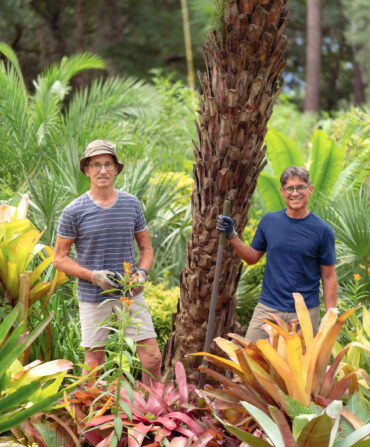By profession, Chip Ervin has an eye for color. For decades, as a custom clothier at the men’s store Grady Ervin in Charleston, South Carolina, he has coaxed clients toward the perfect silk-lined Italian sport coat, fitted generations of young men with their first blue blazers, and anointed tuxedos with vivid pheasant or guinea feather bow ties. So it came as a surprise to Ervin when he began to love a world in black and white.
While he was perusing an antique gallery one day in 1996, Ervin’s eyes locked on a framed Lowcountry landscape intricately cut from jet-black card stock. Spanish moss dripped from a live oak, and deer lurked in the underbrush, recalling the inky black profile of a coastal wilderness at dusk. Ervin took note of the artist’s name, Carew Rice, and purchased the silhouette for a pittance.

Photo: Margaret Houston
Chip Ervin.
Over the next couple of decades, Ervin cast a net for more Carew Rice works. He frequented galleries, attended auctions, and patrolled the web, collecting silhouettes that resonated with him from his own childhood in the outdoors: ducks rising from the water, men bird-hunting by mule, fishermen casting nets, great blue herons wading in salt marsh, and cypress knees dotting blackwater swamps.
It wasn’t until after Ervin had collected a dozen or so such images that his mother made a startling remark: “You know that Carew Rice cut silhouettes of you and your sister when you were children?” Ervin had forgotten that. Then his grandmother unearthed additional pieces that Rice had cut of Ervin’s father and uncle in the 1940s.
Rice was something of a Lowcountry icon in his day. The artist, who died in 1971, lived down the coast from Charleston but traveled to fairs, bazaars, markets, churches, and bridge clubs, deftly and swiftly cutting images to order. “If you lived in or visited Charleston from the 1930s through the 1960s,” Ervin says, “it’s likely Carew Rice cut your silhouette. The Charleston City Market was his hot spot. He’d sit on a folding chair with a small foldout table and a stack of paper. He cranked out portraits in no time.”

Photo: Margaret Houston
The South Carolina Low Country, a Rice silhouette from 1958.
Sara Arnold, the director of curatorial affairs at the Gibbes Museum of Art in Charleston, concurs. “Rice created portraits with precise skill, revitalizing the popular eighteenth- and early-nineteenth-century tradition of paper-cut silhouettes,” she says. “But he also extended the art form to portray landscape scenes—most often of his beloved Lowcountry.”
Ervin has met some of Rice’s descendants along the way, including his grandson Clay Rice, who lives in nearby Mount Pleasant and carries on the silhouette tradition, as well as his grandfather’s knack for storytelling and songwriting.
“Carew was quite the character,” Ervin says. “He wore a beret, wrote poetry, played music. He hummed a tune while he worked. And he worked quickly—no sketch, no template, all freehand—bending and flipping and folding the paper as he went, using dime-store scissors he sharpened himself.”
When Ervin first began collecting Rice’s work, the silhouettes weren’t well known. “Now supply and demand have driven the price up,” he says, “and his work is pretty scarce. It’s been fun to watch his pieces increase in value, but that wasn’t my intent. I bought them because of the way they spoke to me.”

Photo: Margaret Houston
Carew Rice hunting scenes.
Ervin displays most of the silhouettes at his home, but if you walk by Grady Ervin’s shop window on King Street, chances are you’ll spy a few Rice images nestled among the tweed vests, bamboo fly rods, and boutique oyster knives. But they’re not for sale.
“All the pieces I’ve gathered are special in their own way,” Ervin says. “They tell a story, just like Carew sitting there cutting and chatting with his customer. He loved the Lowcountry—the wildlife and surroundings that carry us from youth into adulthood. I wouldn’t sell them for any price.”








